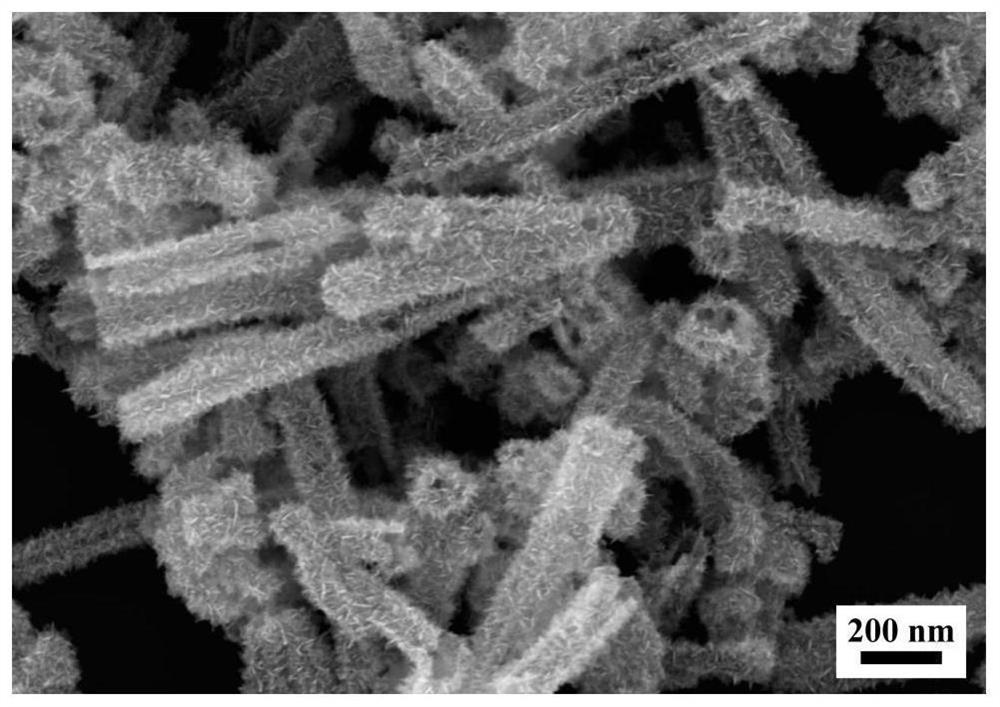Scaled hollow SnSe nanotube self-powered infrared detector and preparation method thereof
A technology of infrared detectors and nanotubes, applied in nanotechnology, nanotechnology, electric radiation detectors, etc., can solve the problems of easy introduction of impurities, achieve high-efficiency electron transmission, improve performance, and be suitable for large-scale production and application.
- Summary
- Abstract
- Description
- Claims
- Application Information
AI Technical Summary
Problems solved by technology
Method used
Image
Examples
specific Embodiment approach 1
[0043] Specific implementation mode one (refer to Figure 4 ): a kind of scale-shaped hollow SnSe nanotube self-powered infrared detector of the present embodiment includes a working electrode, a counter electrode and an electrolyte; Electrolyte is injected into the interior, and the working electrode is FTO glass (300mm 2 ); the surface of the SnSe nanotube is in the shape of fish scales, and the inside is hollow; the counter electrode is a Pt electrode; the electrolyte is a polysulfide electrolyte solution.
[0044] The method for preparing the above fish scale hollow SnSe nanotube self-powered infrared detector is carried out according to the following steps:
[0045] 1. Add 90mL of SeO 2 The mixed solution of β-cyclodextrin and 90mL of ascorbic acid solution were mixed and reacted for 4 hours to obtain Se nanoparticles. The Se nanoparticles were dispersed in 30mL of absolute ethanol at room temperature, aged in the dark for 48 hours, and dried naturally to obtain Se nanow...
specific Embodiment approach 2
[0052] Embodiment 2: This embodiment differs from Embodiment 1 in that simple Ag nanoparticles are deposited on the surface of the SnSe nanotubes; other steps and parameters are the same as Embodiment 1.
[0053] The difference between the preparation method of the fish scale-shaped hollow SnSe nanotube self-powered infrared detector and the first embodiment is that the specific process of step three is: the Se@SnSe nanomaterial obtained in step two is heated at 350°C under the protection of argon Annealing at lower temperature for 1 hour, to obtain SnSe nanotubes with scale-like surface and hollow structure inside, disperse 0.02g of SnSe nanotubes in 30mL silver nitrate solution with a concentration of 0.05mol / L, and use ultraviolet light with a wavelength of 365nm Irradiate for 15 minutes, centrifuge and wash, then dry to obtain SnSe nanotubes with simple Ag nanoparticles deposited on the surface; other steps and parameters are the same as those in Embodiment 1.
[0054] Det...
specific Embodiment approach 3
[0055] Embodiment 3: This embodiment is different from Embodiment 1 in that: the surface of the SnSe nanotube is also coated with SnS. Other steps and parameters are the same as those in the first embodiment.
[0056] In this embodiment, by obtaining the SnS@SnSe nanocomposite material, the recombination of the photogenerated electron-hole pairs of the SnSe nanotube is suppressed, and the detection performance of the device is improved.
PUM
| Property | Measurement | Unit |
|---|---|---|
| Concentration | aaaaa | aaaaa |
Abstract
Description
Claims
Application Information
 Login to View More
Login to View More - R&D
- Intellectual Property
- Life Sciences
- Materials
- Tech Scout
- Unparalleled Data Quality
- Higher Quality Content
- 60% Fewer Hallucinations
Browse by: Latest US Patents, China's latest patents, Technical Efficacy Thesaurus, Application Domain, Technology Topic, Popular Technical Reports.
© 2025 PatSnap. All rights reserved.Legal|Privacy policy|Modern Slavery Act Transparency Statement|Sitemap|About US| Contact US: help@patsnap.com



